
The equatorial and tropical regions skies are badly known as they never formed a category of their own. Most observers are northerners or southerners, as are the main sky patterns. Equatorial skies are interesting however, as they are a subtle blend of both the northern and the southern skies. Equatorial countries are found all along the equator, in South America, Africa, South-East Asia, and the Pacific. At the difference of the northern and southern hemispheres, a observer at the Tropics is able to observe the whole of the celestial sphere
| Observational Environment Equatorial Skies Features | Observing |
(note that this section is the same than the one found at "Naked-Eye Sky Learning 1 (Northern Hemisphere)")
Best possible naked-eye sky learning environment is a free 360° horizon. If not, a backyard is useful anyway. Or even a balcony or a simple window. Even if you see less stars and if you have to learn the sky "slice by slice", you will learn anyway. The most important tip is that your eyes progressively get used to the darkness hence progressively see more stars. This is a well known rule of amateur astronomers. Once in a session, just avoid to expose yourself back to any source of light. Should you have to use any documentation as often the case, just use a red flashlight or use the night vision toggle of your planetarium software. Red flashlight are easily found at amateur astronomy retailers or you may easily tweak one: just find a red-tinted bulb, or paint one, or place any convenient red filter on the flashlight. Should you observe from a city or a building, street lamps or other light sources will surely be unwanted sources of light. Just find the appropriate angle which will elude them and just avoid to expose you back to the sources during the observation session
Another point is that you just have to be comfortable while observing. First, you may observe standing, or sitting on a chair or an armchair, at your convenience. On the other hand, always think about how you will get clothed. Observing is always best done in open air (or with a window opened) and some nights may be cold! Dress accordingly and wear appropriate protections like gloves or good shoes, if needed. You have to feel comfortable. By summertime, be mindful of insects! In case, just warn your neighbours that should they see a strange shadow with heavy woollen hoods on the head, it's just you learning the sky ;-) A last thing too: should you decide to go to some dark place outdoor to have a better horizon, just think in terms of safety first. Dark places, reasonably, are not the safer places around!
Typically at the equator you have the celestial equator running from East to West, through the zenith. The celestial equator is just over you head running East-West. The Polaris is just on the northern horizon as the south celestial pole is just on the southern horizon. As one might think that such a location is allowing to see a sky partly northern, partly southern, this is not exactly the case. Such a location at the equator is better giving subtle skies where northern and southern skies are blending in interesting figures
On the other hand the equator is the place on Earth where the days' length is equal to nights'. Each day, all year long, the Sun is rising at about 6:00 a.m. local time, as it is setting all year long at about 6:00 p.m.. A slight oscillation of the ecliptic is seen bringing the Sun to rise and set at its southeast/southewestmost at the winter solstice or at its northeast/northwestmost at the summer solstice. The Sun is rising and setting full East and West at the spring and fall equinoxes
Further, the ecliptic is mostly vertical which means that the planets and the Moon, and the Sun too, are mostly seen lying on their equator
At last another typical feature at the equator is the shortness of the twilight, with a rapid transition from day to night, and from night to day. This is mainly due to the sharp angle the ecliptic is always making to the horizon. The complete darkness of the sky is usually reached in about 25 minutes at night, as the day is appearing very quickly too. The steep angle of the ecliptic to the horizon makes that the zodiacal light ('CZL' for 'Coronal and Zodiacal Light') is likely to be noticed under the tropics. From dark clear sites, zodiacal light looks like a faint diffuse white
glow seen along the ecliptic in the night sky after the end of twilight, or before dawn
->More About The Zodiacal Light and The Gegenschein
The zodiacal light is a faint, diffuse, and roughly triangular white glow, which may be visible in the night sky. It extend along the zodiac, from the Sun. It is caused by a interplanetary dust cloud scattered in the inner solar system's plane well beyond Earth (that dust really is differentiated into more or less pronunced areas). It was the Pioneer space mission which in 1970's allowed to scientifically check that explanation. Such that dust originates at Jovian comets, or from the Asteroid Belt, as it spirals eventually unto the Sun hence that need to be replenished. At the tropics, zodiacal light is seen all year long after twilight entirely disappeared or did not begin to appear. In the northern hemisphere the zodiacal light glow is better seen after sunset in spring and before sunrise by fall. Those epochs are when the zodiac is at a steep angle to the horizon. The reverse is true in the southern hemisphere. Make sure in any case of the absence of light pollution, or Moon not in the vicinity. In dark skies, the zodiacal light may be seen like a 5 to 10 degree-wide band either side of the Zodiac (in that case it is called the 'zodiacal band' or 'zodiacal bridge'). The zodiacal light, generally, can cast shadows. Zodiacal light is of importance in the Muslim culture as it may be mistaken with the beginning of dawn, a time for determining daily prayers, as pre-Colombian Mexicans were aware of it too. Muslims call the zodiacal light 'false dawn' when seen before sunrise. Zodiacal dust also exists around nearby stars as it is called 'exozodiacal dust,' and potentially a source of noise for imaging exoplanets as the zodiacal light seen from any other planet in our Solar System
The 'gegenschein' -- German for 'countershine' -- as far as it is concerned, is a feeble but slightly brighter oval glow at the point in the Zodiac directly opposed to Sun. It is some 10-15 degree-wide and aligned on the ecliptic plane. Even the Milky Way is a hindrance to see the gegenschein. It is best seen at fall in the northern hemisphere and, generally, by midnight. It was first observed by about 1730. In best conditions the zodiacal bridge may be seen linking the gegenschein with the zodiacal light
For clarity and use, stars you see in the night sky, are grouped into constellations. Constellations are boundaries inside which a group of stars are seen close together, much of them evoking a figure. In most cases these stars are vastly distant from each other and they are seen forming the constellation figure only by an effect of perspective. As seen from Earth, they are looking like they are close together . Diverse civilizations saw diverse objects, myths or symbols into the skies. The constellations we are using today are mostly due to the Babylonians and Greeks as most of southern contellations were added when discoverers of the 16th century ventured into the southern hemisphere. Definitive constellations boundaries were fixed in 1930 by the International Astronomical Union (IAU). Constellations, for both hemispheres, are at the number of 88. On the other hand, amateur astronomers are used to memorize some alignments which help to find one's way to a constellation or to identify such or such star. At last different parts of the sky are seen along the year due to Earth's revolution along its orbit. It may be assumed that each season comes with its pattern of constellations and stars. All this brings that sky-learning is working along the four seasons. From winter to fall you will learn what constellations are seen in the sky and how to find and identifiy them. Strictly speaking most equatorial countries do not have any delimited seasons like those found in the northern or the southern hemisphere. Temperatures, vegetation, and the length of days are remaining identical all year long! The calendar dates for the four seasons remains useful landmarks however
For any observational purpose, you will have to learn what part of the sky is at your disposal. As a rule of thumb, should you usually see the sun setting, this means that you observation post if facing West. Should you usually see the Sun rising, you are facing East. About midday, Sun is about your North. Hence South is in the opposite direction. A better way to find too is to use a chart, or a compass. Remember that, facing South, you have the celestial equator directly overhead and most of the time, the ecliptic too, which means the planets
The logics for our night sky learning training, as exposed herein, is a logics usually admitted by the amateur astronomers community. It's mostly based on the use of two sky charts, a one concerning the western, and the other the eastern horizons. The trainee thus will just have to follow, charts in hands, our text as our method mostly is juxtaposing and descriptive. That means that you will have to spot the constellations from the charts, and to follow our descriptions! Of help to check you identify well constellations, are some softwares useable with your smartphone -- some advanced and also used with a computerized telescope. That works by pointing the smartphone in the direction of a constellation and having its name, bright stars, etc. You will also note that, as far as our site's charts are concerned, they do not bear, by a worry of legibility, any name of the bright stars. As our description refer to such names, just consider that those mostly are, on the chart, the brightest star of the constellation in question
Observation tips are given for night's first part, that is about 10:30 p.m. local time. 'Season' is understood like the time about the middle of it, like, for example, about early November for fall. Color maps with Stellarium. Printer-friendly charts with Cartes du Ciel, Patrick Chevalley. The Great Dipper and the Polaris as the Southern Cross and the south celestial pole charts are hand-drawn composites. Each night, the celestial sphere is shifting to the western horizon by 15 degrees per hour. From one month to the next, for a same latitude, a star or constellation will be found back at the same position in the sky with 2 hours earlier
A early twilight at the tropics and the equatorial area may have looking seemingly late the usual time at which the observation of the night sky is considered to be performed in the northern, or southern hemisphere, about 10:30 p.m., local time, by the amateur astronomical community. A worry of homogeneity however has brought us to keep that time for the tropics too. The observers in the area, who may practice earlier, will thus have to extrapolate our descriptions
->Caution! A current tendency of the astronomical softwares and charts is to shift from the constellations' shapes as they are usually defined and recognized by the amateur astronomy community. The following color charts on this page are those which are shifting the most in this regard, as the printer-friendly charts are those who do less and are the ones to be used to memorize the basic shapes of the constellations, albeit still not completely accurate. read more!
| North, South Winter Sky Spring Sky Summer Sky | Autumn Sky Circumpolar Constellations Alignments of Stars. Concept and Use |
Like for northern or southern hemisphere, some developments are useful about the Polaris or the Southern Cross as a mean to locate the north or south celestial pole, not such thing is useful at the equator. The Polaris is just North on the northern horizon as the south celestial pole is just South on the southern horizon. The celestial equator is running overhead East-West. Once this direction verified with a compass or a map, the south celestial pole is just South, on the horizon as the north celestial pole is just North on the horizon
 | click to the Great Dipper and the Polaris at the equator |
The north pole is further indicated by the Polaris which is literally lying on the horizon -and sometimes below- hence difficult to see. A way to guess where it is is to use the trick used in the northern hemisphere to find it, that is the Great Dipper. At the equator this trick is useful from mid-January to mid-June only as, outside this period, the Great Dipper is not visible for this purpose. The Great Dipper is an asterism, part of the constellation Ursa Major, the Great Bear. The Great Dipper is a quadrilateral at the top left spike of which an arch of 3 stars is extending. The accompanying chart is showing the Great Dipper positions from February, 1st to June, 1st. Once accustomed to the method, you will be able to use it 15 days before and 15 days after. Once the Great Dipper spotted just look for the two stars which makes the outer, righmost edge of the quadrilateral. The Polaris is just at the end of a line extended from these. Strictly, the Polaris is not always visible on the horizon since it is not exactly at the north celestial pole. Hence it has a proper apparent motion. It is not visible, at the observation hours, between mid-April and the end of June. The Polaris is part of the constellation of Ursa Minor, the Litlle Bear, which is better seen like a Little Dipper. The Little Bear itself is not visible between the beginning of September and mid-March
As far as the south celestial pole is concerned, it bears no landmark identical to the Polaris. Southerners are using Crux, the Southern Cross instead. It's an imperfect tool however as the Southern Cross in under the horizon from mid-September to early December. At the equator the Cross is unusable from about after July, 8th until about February, 1st. Crux, the Southern Cross is a small constellation embedded in the Milky Way. Its shorter axis is wide like both stars either side of Altair. Its main axis is pointing to the south pole. The first accompanying chart will help you to find it. On the other hand an additional method is used in the southern hemisphere. It's unavailable too during a part of the year. It's using Canopus (a of Carina, the Ship's Keel). It is one quarter of sky off the Southern Cross, at the same distance from the pole than the latter. Just draw a line from Canopus to the line determined by the Cross' main axis. Where the two lines meets at about an angle of 90°, there fairly is the south pole. Canopus, at the tropics and the equator, is useable, along with Crux, the Southern Cross, between about February 1st and about April 20th only
 |  | click to Crux, the Southern Cross, showing the south celestial pole (left) and to Canopus as an additional mean to the Southern Cross (right) |
Let's begin with the skies of the winter solstice! The sky, at the tropics, at that period, first, are mostly remarkable southeast and south. Just turn South! Here is the large band of the Milky Way, which begins to the southeast and which heads to the zenith! All the constellations which are seen against the background of it are, above all, the three constellations which were born, in the 18th century, of the observational needs, for praticity, to share the ancient, and vast constellation of Argo, the Ship. Argo, for the Ancients, was a sole and main constellation, figuring that famed ship of Jason and the Argonauts, which had left aboard for the quest of the Golden Fleece, which they eventually had maybe found in the current days Georgia, along the Black Sea. The ship Argo, along the journey, progressively was replaced for each of its parts, eventually becoming at the end of the journey, a same ship, and a one entirely different! Here are those three constellations which were then created -from bottom to top- Carina, the Ship's Keel, Vela, the Ship's Sails, and Puppis, the Ship's Stern. The bright star, about due South, high, is Canopus, which belongs to Carina. For those who could afford a really plain horizon, they might try to catch some glimpses of Crux, the Southern Cross, which is now just lying unto the horizon. Another object of interest in the field is the Large Magellanic Cloud, a fine sight. Let's have a look too to the zenith! The bright star, high, is Sirius, the brightest star in the sky. It's the main star to constellation Canis Major, the Great dog. Frankly to the zenith, check that large quadrilateral of stars, with three aligned in its center. This constellation is the famed Orion, Orion, with, below the three stars -which are called the 'Orion's Belt- the famed Orion Nebula, that faintly glowing object, another fine sight! Orion, with the other fine constellations which are currently lying to the zenith, are what the northerners, during their winter, do consider like the 'great winter sky', a remarkable ensemble of bright stars and fine constellations which are seen, in the northern hemisphere, South during winter
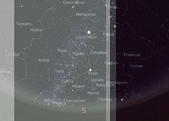 | click to winter's southern horizon. retrieve a printer-friendly chart |
Let's pass West now! As Orion, Orion, high is found back, high, let's keep in that region, and to lower right, and the right of it, let's see two other constellations of the northern hemisphere's great winter sky. Just follow the line of the Orion's Belt downwards; that's leading you to a bright star, lying among a V-shaped cluster of stars. It's Aldebaran, of Taurus, the Bull, and the Hyades, a loose open cluster. Keeping further, just spot those specks of stars, tightly fit into a small pack of them. It's the fine Pleiades, another open cluster of stars! To the right of Orion, high northwest, spot another bright star. It's Capella, of constellation Auriga, the Charioteer. Lower, under Auriga, Perseus, Perseus is another fine view and field of interest. Perseus, among other, is featuring the famed, variable star Algol. As a part of Cetus, the Whale is seen due West, the other main field of interest however is the famed Eridanus, the River. This celestial river, which was already seen under that form in the Antiquity -and maybe like the Nile River- is a fine, long chain of stars, which is taking its source at Rigel, the bright star to the lower right of the quadrilateral of Orion, Orion, and then is meandering a long way, heading to the southern hemisphere of the night sky! Eridanus is ending its course at a bright star, called Achernar, which means 'the end of the river' in Arabic. Achernar, is featured on the chart but you'll need a plain horizon to really see it in the sky!
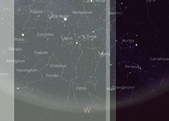 | 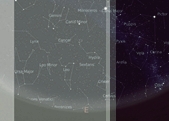 | click to winter solstice's western horizon (left) and eastern horizon (right). retrieve printer-friendly charts (western horizon, eastern horizon) |
Now, let's end that first journey into the night sky with the eastern horizon! The whole southeast of the sky, of course, is partly filled with the Milky Way-embedded southern constellations that we saw on the southern horizon. The next sight of interest is lying on the same direction, from the horizon towards the zenith, albeit the field is fainter. It's the fine chain of Hydra, the Hydra, a fine and long set of stars, which is fine to observe and spot. Hydra, high, is finding its end into a fine small loop of stars. Three small constellations -albeit one of its is low now- are anchoring along, with Corvus, the Crow, Crater, the Cup and Sextans, the Sextant. Albeit high, just give a look to Cancer, the Crab, near the Hydra's head. It's a small and faint constellation which is famous for harbouring the M44 open cluster, Praesepe or the Beehive, a much fine sight. The cluster is lying just near the two central stars of the constellations. Other sights further now! Leo, the Lion, is already well rise, about northeast. Leo is the lion which had fallen from the Moon into the region of Corinth, in Greece, and Hercules had to fight it. Constellation Leo is finely figuring this animal it's supposed to. The constellation renders well a crouched Lion, with Regulus at the fore, and Denebola -meaning 'the lion's tail' in Arabic- at the rear. The curved asterism of stars which is taking at Regulus, a fine sight, is called the 'Leo's Sickle'. The faint Lynx, the Lynx is high, northeast, as, under it, parts of Ursa Major, the Great Bear, are seen, and worth the look too
As we are having now the vernal equinox, the skies treat us with a remarkable view, likely with no equivalent elsewhere in the world -excepted in the southern hemisphere where the show is arching higher in the sky. That view, a fine one, is the one of a whole set of southern constellations as they are embedded into the Milky Way! Those Milky Way-embedded constellations are the distinctive feature of the night sky in the southern hemisphere! See that magnificent show which is lying from due East, to about West! East, the show, to the lower right of Ophiuchus, the Serpent Holder, is beginning with the inspiring sight of the center of our Milky Way Galaxy. See all those draperies of gold and coal! It's there that the center of the Milky Way Galaxy is lying, that old bulge of yellow stars, at which the blue, spiral arms of the Galaxy are taking, with their younger stars! When looking toward the Milky Way galaxy center, dark patches seen are dense dust clouds in a inner spiral arm of our Galaxy blocking our view of stars toward the center. The center of our Milky Way Galaxy further, beyond those walls of stars, is featuring, like most galaxies -like astronomers now know- a gigantic, galactic black hole -the size of the orbit Mercury- which is a place of the highest danger in the Universe. Black holes indeed are the places of the highest and largest density and gravity in the Universe, catching and trapping all what's passing around and never to be released! Not even light, with its highest speed in the Universe! A step further now, and just see that other striking sight of Scorpius, the Scorpion! Another constellation which is well rendering the animal, or concept, it's supposed to. The tails of Scorpius is at the bottom of the sky, as the head, with Antares and the arch of stars marching ahead, above. Antares is a fiery, red-glowing star and it owes it's name to that color, as the name, in Greek, is meaning 'rival to Mars'. The astronomers, in the Antiquity, had noticed that Antares was as fierce as the planet Mars! Catching Norma, the Square and Lupus, the Wolf, now, we eventually reach Centaurus, the Centaur. The main sight there is those two bright stars, close together. Those are Alpha Centauri, and Agena. Both those stars are known like 'the Pointers'. The reason is easy. It's because they are 'pointing' towards Crux, the Southern Cross. As now, we just are facing that jewel of that part of the sky, and of the southern hemisphere!Alpha Centauri is the famed Alpha Centauri, that is the star which is nearest to us, at 4.35 light-years. Crux, the Southern Cross, is the sky's smallest constellation, and under a form of a cross. Left of the tip of it, just spot that dark patch against the Milky Way. It's the typical "Coalsack", a dark interstellar cloud of gas and dust which masks the stars behind. Beyond the Southern Cross, now, are to be found those constellations that -like we learned it during winter- had been born from the partition of the vast, ancient ship Argo, for observational purposes during the 18th century. Carina, the Ship's Keel, Vela, the Ship's Sails, and Puppis, the Ship's Stern (now low) that is. Some typical southern constellations may be caught, low, like Ara, the Altar, or Triangulum Australe, the Southern Triangle. All that great show is thus providing for fine sights. That part of the sky further is providing us with Omega Centauri (NGC 5139), a globular cluster shining at the 3.7th magnitude, top left of the Southern Cross. It is found on the line Agena-e Centauri, a little less than the distance between the two stars. See too the famous False Cross, which is a group of stars looking like a larger but fainter cross
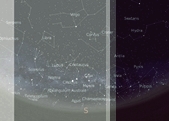 | 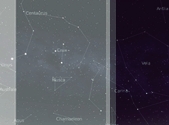 | click to spring southern horizon (the southern embedded constellations in the Milky Way) (left) and to Omega Centauri, the False Cross (right). retrieve printer-friendly charts (southern embedded constellations in the Milky Way, Omega Centauri, the False Cross) |
Let's keep the tour West! The faint chain of Hydra, which we had found during winter East, is now West, keeping being a fine field, with that long chain of stars ending at that small loop of stars, and three small, fine constellations anchoring along, Corvus, the Crow -near the zenith-, Crater, the Cup, and Sextans, the Sextant! The faint Cancer, the Crab, lower is fine too, as we can find again the fine M44 open cluster, or Praesepe, or the Beehive, which is lying close to the two central stars of the constellation. Hight, Leo, the Lion is there too, with Regulus and the asterism Leo's Sickle. Frankly northwest, the Great Dipper, along with Ursa Major, the Great Bear, is a fine sight, allowing for a mighty view of the constellation, emblematic to the skies of the northern hemisphere
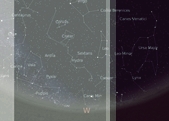 | 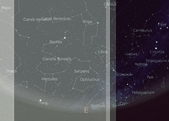 | click to spring western horizon (left) and to spring eastern horizon (right). retrieve printer-friendly charts (western horizon, eastern horizon) |
Let's end that great tour with the eastern horizon! Let's turn East! The whole southeastern part of the sky is harbouring those part of the Milky Way-embedded constellations we saw from the South and which are a fine sight from there, too, to our right! Ophiuchus, the Serpent Holder is there, East. Ophiuchus is the personnification in the sky of Asclepios, the Greek god of medicine, as it's sided by its two serpents, which he used like his herb-finders. A part of the lower one is missing. The bright star, high, near the zenith, is Spica, of Virgo, the Virgin. Those with an interest into the deep-sky objects, have now that region, along with Coma Berenices, the Berenice's Hair, which is harbouring such objects. Northeast, other sights are interesting, and to see. Hercules, the Heroe is a constellation with a central quadrilateral -which is called the asterism 'Keystone'- from which extensions are taking. Hercules is famously harbouring the M13 globular cluster, or the 'Great Cluster in Hercules', a fine binocular object at the 5.9th magnitude! M13, currently is to be found on the upper side of the quadrilateral, at one-third the length of it, right of the left star. Corona Borealis, the Northern Crown is a fine constellation above, as higher still, that bright star is Arcturus, with the kyte-shaped constellation of Bootes, the Herdsman, attached along. Arcturus, along with Spica are famed in the Anglo-Saxon astronomical world through a saying which says 'Arc to Arcturus, speed on to Spica', meaning that those both stars may easily be found using an alignment starting at the handle of the Great Dipper. This is verifiable currently. Just spot the Great Dipper, and the arch of stars which constitutes its handle. Just extend the arch in the sky. And here is Arcturus. Further, and it's Spica. Well, here we have reached the end of that journey into the skies of the spring equinox in the regions of the equator and the tropics, as we scoured vastitudes and much fine views!
About the summer solstice, the sky, at the tropics is tending to be southern somewhat, with a whole set of typically southern constellations ready for exploration. Let's begin our tour with the southern horizon and let's get ready for inspiring sights too! From the southwest to the zenith, we first immediately spot the band of the Milky Way. And there too, we found back some of those Milky Way-embedded constellations we have seen are shining against the Milky Way. And with, now, the plain show of the Milky Way Galaxy's center, high in the sky. Let's swiftly spot the Pointers, low, let's pass Ara, the Altar, Norma, the Square, and Lupus, the Wolf, as we are now reaching those regions of Scorpius, the Scorpion and Sagittarius, the Archer where the center of our own Milky Way Galaxy is lying! Before getting deeper into those incandescent draperies in the sky, just have a look to Scorpius further! The faint constellation of Libra, which is to its right, was, by the Ancients, not considered a constellation of its own, but its stars were constituting the claws of the Scorpion, adding to the realism of the constellation! Back to those draperies of the Milky Way now! There, high in the sky, we are seeing the densest and most spectacular views of the Milky Way. It's just because, what we are seeing is just the center of the Milky Way Galaxy! With our Sun, we are living inside a galaxy, a gigantic set of thousands of billion stars, and one of those spiral galaxies which have been popularized by the media, with their central bulge of old, yellow stars and the spiral arms, of blue, younger stars, taking there and giving the aspect of a firework pinwheel. Our own Milky Way Galaxy is just looking like that. Might we see it from the outside! The trouble however is that we are inside the Milky Way Galaxy and that in no case one can afford that sight. And, we are just having the Milky Way instead! The Milky Way is just when, either side of where we are, with the Sun, in the Galaxy, we are looking into the plane of it. As we're seeing the Milky Way Galaxy edge-on, that gives the Milky Way. And the distances in there are so vast, that we can't see the stars of the arms and the bulge individually any more, as they are just melting into those luminescent draperies and walls of stars and gas and dust clouds. There, in Sagittarius, the Archer, not only do we peer into the plane of the Milky Way Galaxy but we do peer into the plane, and into the center of it, towards the bulge! An inspiring sight, with those spiral arms taking either side, about Norma, the Square, on one side, and, near the zenith, near Scutum, the Shield and Aquila, the Eagle! When looking toward the Milky Way galaxy center, dark patches seen are dense dust clouds in a inner spiral arm of our Galaxy blocking our view of stars toward the center. And that not all! Deep inside those draperies, is lying a titanic, galactic black hole! A black hole, in the Universe, is the location of the highest and largest density and gravity you can ever find. Everything lurking around is definitively swallowed and forever trapped inside. Not even light, with its speed the Universe's largest, can get out of a black hole. The black hole, at the center of the Milky Way Galaxy is the size of the orbit of Mercury! A much dangerous place. Such galactic black holes, the astronomers know now, are found in about each galaxy...
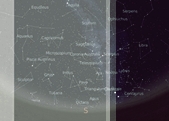 | click to summer southern horizon. retrieve a printer-friendly chart |
Well. Just get slightly more southeast now. Here is another sight you must stay a while to. Here are a whole set of typically southern constellations, from Piscis Austrinus, the Southern Fish, to Pavo, the Peacock, and to Telescopium, the Telescope. It's a fine training to spot those, and to be able to well delineate them. The brightest star of Grus, the Crane, is called Alnair. The bright star at Piscis Austrinus is the well-known Fomalhaut, the name of which, in Arabic, is meaning 'the fish's mouth'. Check too Indus, the Indian. Most of those southern constellations, like often, are bearing the name of exotic birds or animals, or a science tools, as they were named at the time of the Great Discoveries by the European navigators or somewhat later by dedicated astronomers
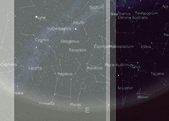 | 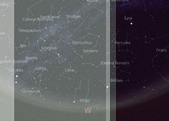 | click to summer eastern horizon (left) and to western horizon (right). retrieve printer-friendly charts (eastern horizon, western horizon) |
As we're hanging about the southeast, just let's get to the eastern horizon! Let's turn East as further fine sights are waiting. Capricornus, the Goat, and Aquarius, the Water Bearer, two zodiacal constellations, are fields fine to check and delineate. The small loop of stars, lower, is the asterism 'the Circlet', which is part of Pisces, the Fishes. To its left, see that large square of four stars! It' just the famed Great Square of Pegasus, with one of the stars, by the way, belonging to Andromeda, Andromeda (the lower left one), the line of which currently is under the horizon. Lacerta, the Lizard is seen too as a show which is of interest and better seen on the northern horizon is the famed, too, Summer Triangle. Let's proceed to the North now. And high, just spot those three bright stars. They are constituting, justly, this triangle of stars. 'Summer' stands for that this figure of stars is the distinctive one, in the northern hemisphere, during summer. Northerners are getting the view on their South! The three stars of the Summer Triangle -Altair, Vega, and Deneb- are the main stars to constellations Aquila, the Eagle, Lyra, the Lyra, and Cygnus, the Swan, respectively. All of them further sights per se, like Aquila mostly seen like both stars either side of Altair, Lyra like that small quadrilateral affixed to Vega, and Cygnus that large cross against the background of the Milky Way! Further much fine sights!
After such a lot of marvels already, let's try to find some time still for the western horizon, where we'll find back constellations we already now. Hight, slightly southwest, is Ophiuchus, the Serpent Holder, with its two serpents now well seen entirely. Libra, the Scales, like we saw, was, in the ancient times, linked to Scorpius. Low, just check back Arcturus and Bootes, slightly northwest, as Spica of Virgo, the Virgin, is now much low and will need a plain horizon to be seen. Hercules, the Heroe is northwest too, with Corona Borealis below. Hercules is the occasion to have some look again to M13, the Great Cluster in Hercules. It's currently now along the lower side of the Keystone, at one third of the length from the right star
At the tropics, at the times of the autumnal equinox, we'll find back views we have already seen along with some patches of interest. Let's first have a look South, where both the Magellanic Clouds are nearing their best. The Large and the Small Magellanic Clouds are satellite-galaxies to our Milky Way Galaxy, similar to those companions which are seen along the Andromeda Galaxy. Both the Magellanic Clouds are circumpolar, that is that they are visible all year round, never descending under the horizon. They are owing their names to the Spanish explorer Magellan, who was the first, in the 16th century, to perform a round trip around the world. It's likely he was the first ever to see those celestial objects! The Large Magellanic cloud (LMC) is about 5-degree wide. It's located at the border of the constellation Dorado, the Swordfish. The Small Magellanic Cloud (SMC) is 2-degree wide, as it's the constellation Tucana, the Toucan. The Large Magellanic Cloud is so important that even a bright Moon doesn't hinder its sighting
Shoud we turn West, now, just consider the southwestern part of the sky! Much typically southern constellations we already saw, or that we're having the opportunity to learn! Check back, from the zenith to the horizon, Phoenix, the Phoenix, Sculptor, the Sculptor, Tucana, the Toucan, Indus, the Indian, or Microscopium, the Microscope! Grus, the Crane, with Alnair, and Piscis Austrinus, with Fomalhaut are available too. Capricornus, the Goat, and Aquarius the Water Bearer are in those surroundings now, further opportunities to check those zodiacal constellations. Since the most ancient times, the region of Capricornus had been linked to the concept of waters. High, the Circlet, and the Great Square of Pegasus. Cygnus, the Swan, of the constitutive parts of the Summer Triangle, with Deneb is now mostly tending to the horizon, where Altair, in Aquila, the Eagle, have already reached. Equuleus, the Little Horse, and Delphinus, the Dolphin are two small constellations associated to the region of the Summer Triangle, and fine to see
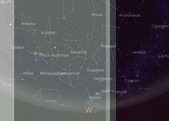 | 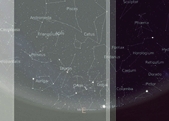 | 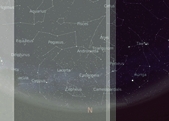 | 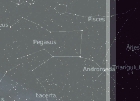 | click to fall western horizon (top left), eastern horizon (top right), northern horizon (bottom left), and the Great Square of Pegasus, Andromeda, M31 (bottom right). retrieve printer-friendly charts (western horizon (top left), eastern horizon (top right), northern horizon (bottom left), and the Great Square of Pegasus, Andromeda, M31) |
As we turn East now, more fine views are awaiting, confirming an idea that the sky at the tropics are not a simple juxtaposition of the northern, and southern skies but a subtile blend of both, with juxtapositions of patches of sky of interest. Southeast, some other typically southern constellations. Just pick Caelum, the Chisel, Horologium, the Clock, or Reticulum, the Reticle! For those with a plain horizon there, the lower, bright star, is Canopus, of Carina. The show is due East too, with the quadrilateral of Orion, Orion lying on its side, a much fine sight. Check that vast quadrilateral of stars, with three aligned in the center. Betelgeuse is the lower left star, and Rigel the upper right one. The Orion Nebula is currently seen right of the three central stars. Like we already saw, at Rigel, Eridanus, the River, that celestial, antique river is taking its source. It's seen back, winding its long way into the sky, up to the bright Achernar -'the river's end' in Arabic- high southeast. A much fine sight, worth a detailed observation, with binoculars, for example! Cetus, the Whale, high, is taking at one of the meanders of Eridanus. Taurus, the Bull, to the upper left of Orion, the Hunter is having Aldebaran, its main star, among the stars of the V-shaped Hyades cluster, as higher still, one finds the small and much pleasant cluster of the Pleiades! Perseus, Perseus, and Auriga, the Charioteer, the one with Algol and other objects, the other with the bright Capella are adding to the journey!
Like a conclusion for our journey into the sky of the fall equinox, at the tropics and the equator -and by the same way, like a conclusion to this introduction to the skies of those regions of the Earth, let's now turn North where, high, we'll have the opportunity to check a celestial celebrity, the Andromeda Galaxy, or M31. As fine, typically northern constellations are seen a row below in the sky, with Lacerta, the Lizard, Cassiopeia, the Queen, or Cepheus, Cepheus (which is low), the upper parts of the sky are featuring the Great Square of Pegasus and, starting at its lower right star, the line of Andromeda, Andromeda. Andromeda is famously harbouring the M31, Andromeda Galaxy, a twin to our own Milky Way Galaxy and a picture of it, should we be able to see it from the outside. M31 is an easy binocular -and even naked-eye object- at the 4.8th magnitude. It's easy to use a star-hopping method to find M31. Just start at the corner of the Great Square. Then goes down to the second bright star on the line of Andromeda. Thence, turn to the lower left. Find a fainter star, then a fainter still. The Andromeda Galaxy is just there. A much fine and remarkable sight, one of those other universe-islands which the Universe is populated by. The Andromeda Galaxy, on the chart, is the fuzzy oval
The standard way to learn the sky is, like you did, from season to season, and through the horizon. Seasoned observers however do know that 'alignments' of stars allow to find one's way too into the night skies. Alignments of stars are just general and/or accurate directions given by two or more stars, which lead to such or such constellations or region of the sky. As the Great Dipper is, in the northern hemisphere, a major landmark in terms of alignments, it's merely very partially available only at the tropics and the Equator. And the same for the landmarks used in the southern hemisphere, Crux, the Southern Cross, and Canopus that is. One doesn't find back, for the tropics, thus, those alignments which, North, are allowing to find back the main sky areas which are characteristic of such or such season of the year (such alignments, North, in any case, mostly are used outside of the season proper). At the tropics and the Equator thus, the alignments which we are stating below will just allow you to get your way more easily along the sky areas of a given season only. At the opposite, further, of the alignments used in the northern hemisphere which, for example, are some sorts of classics and thus which you'll gain to memorize, use the following alignments like additional techniques only with the tutorials given above, on that page, for the skies of each of the year's seasons! You'll note, at last, that in those skies of the tropics and the Equator, that's not so much constellations -or areas of the sky- which are constituting the easy landmarks to be used but bright stars instead
 | click to alignment of stars to be used in the sky, at the tropics and the Equator, at the time of the winter solstice (no printer-friendly chart) |
. Alignment of Stars to be Used in the Sky, at the Tropics And the Equator at The Time of the Winter Solstice
 | click to alignment of stars to be used in the sky, at the tropics and the Equator, at the time of the vernal equinox (no printer-friendly chart) |
. Alignment of Stars to be Used in the Sky, at the Tropics And the Equator at The Time of the Vernal Equinox
 | click to alignment of stars to be used in the sky, at the tropics and the Equator, at the time of the summer solstice (no printer-friendly chart) |
. Alignment of Stars to be Used in the Sky, at the Tropics And the Equator at The Time of the Summer Solstice
 | click to alignment of stars to be used in the sky, at the tropics and the Equator, at the time of the autumnal equinox (no printer-friendly chart) |
. Alignment of Stars to be Used in the Sky, at the Tropics And the Equator at The Time of the Autumnal Equinox
Here we are! You now have learned how the equatorial regions are not only about northern and southern skies but are a subtle blend of both. From there most usual figures of the northern skies like Leo, the Lion or Orion are seen high at the zenith as, on the other hand, it's obvious that along three seasons in a row, the southern horizon offers remarkable views of the southern hemisphere sky. You may consider you just entered the amateur astronomers community of the equatorial regions! Should you feel that some parts of the sky are still badly understood, do not hesitate to come back to some parts of this page and to deepen your skills. On the other hand, each month, on this site, at the "Monthly Sky" section, you will find a view of the monthly western and eastern horizons. This will provide you with further insights as other tutorials about observation or about theory are helpful too
Website Manager: G. Guichard, site 'Amateur Astronomy,' http://stars5.6te.net. Page Editor: G. Guichard. last edited: 11/3/2014. contact us at ggwebsites@outlook.com